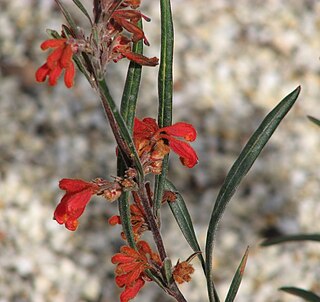
Actinotus is a genus of flowering plants in the family Apiaceae, subfamily Mackinlayoideae, with about 18 species. It is native to Australasia. Its best known member is the flannel flower, a common sight in Sydney bushland in the spring. The generic name, meaning "furnished with rays" is derived from the Greek stem aktin-/ακτιν- "ray" or "sunbeam".

Xanthosia is a genus of plants of family Apiaceae, but sometimes also placed in Araliaceae or Mackinlayaceae. It comprises 20 species of shrubs endemic to Australia. The habit may also be as a herb. They are found in all Australian states, but not found in the Northern Territory.

Actinotus helianthi, known as the flannel flower, is a common species of flowering plant native to the bushland around Sydney. It was named and first described by the French botanist Jacques Labillardière in his Novae Hollandiae Plantarum Specimen the first general flora of Australia. According to historian Edward Duyker Labillardière could not have collected the type specimen personally and might have received it from Jean-Baptiste Leschenault de La Tour botanist on the expedition of Nicolas Baudin or another early French visitor to New South Wales.

Hypocalymma is a genus of evergreen shrubs in the myrtle family Myrtaceae described as a genus in 1840. The entire genus is endemic to southern Western Australia.

Grevillea bronwenae is a slender shrub that is endemic to the south-west of Western Australia.

The Drummond Nature Reserve is an A class nature reserve 10 kilometres west of Bolgart, Western Australia. Named after the botanist James Drummond, the reserve has 439 species of vascular plants within its boundaries, including two rare and seven priority species.

Laxmannia is a genus of tufted perennial herbs in the family Asparagaceae, subfamily Lomandroideae, that are endemic to Australia.

Blancoa is a monotypic genus of perennial herbs in the family Haemodoraceae; the single species is Blancoa canescens, commonly known as the winter bell. It is endemic to the southwestern corner of Western Australia. It has nodding red to pink flowers, a clumping habit and grows to be 10 to 40 cm in height. The genus is named in honour of Francisco Manuel Blanco, a Spanish friar and botanist who compiled the first comprehensive flora of the Philippines.

Actinotus minor, the lesser flannel flower, is a common plant growing in heathland in moist areas not far from Sydney, New South Wales, in Australia. A small shrub, 15 to 50 cm tall, with white flowers, similar to the related and more famous flannel flower.
Adenanthos × pamela is a naturally occurring hybrid of A. detmoldii and A. obovatus in Western Australia.

Grevillea maccutcheonii, commonly known as McCutcheon's grevillea, is a rare shrub in the family Proteaceae. It is endemic to south-western Western Australia, where only 7 mature plants remain in the wild. It usually grows to 2 metres in height and width The distinctively-shaped leaves are stem clasping with 3 rounded lobes, each tipped with a spine. The flowers, which have a reddish green perianth and a red style, appear predominantly between July and November in the species' native range, but may appear sporadically throughout the year.

Johnsonia pubescens, commonly called the pipe lily, is a grass-like plant in the family Asphodelaceae, subfamily Hemerocallidoideae, endemic to the south-west of Western Australia. As with others in the genus, it is distinguished by its minute flowers which are on the end of a spike and hidden by large, overlapping, papery bracts.
Gregory John Keighery is an Australian botanist. Since 2003 he has been a senior research scientist at the Science and Conservation Division of the Department of Biodiversity, Conservation and Attractions of Western Australia. His main expertise is in the native plants of Western Australia, particularly weed flora and the Apiaceae, Liliaceae and Myrtaceae.
Grevillea fuscolutea is a shrub of the genus Grevillea native to a small area along the south coast in the Great Southern region of Western Australia.

Darwinia foetida, commonly known as Muchea bell, is a plant in the myrtle family Myrtaceae, and is endemic to Western Australia. It is a small upright shrub with greenish coloured nodding flowers at the apex of the stems, that have an unpleasant odour. This is a very restricted species, known from only a couple of locations.

Actinotus moorei, the splitleaf flannelflower, is an endemic Tasmanian perennial herb in the family Apiaceae. It is found in wet ground at high elevation in Tasmania's Central Plateau as well as western and south-western mountains.

Actinotus leucocephalus is a small plant in the Apiaceae family, endemic to Western Australia.

Actinotus novae-zelandiae is a plant in the Apiaceae family, native to the South Island of New Zealand.

Actinotus forsythii, the pink flannel flower or ridge flannel flower), is a plant in the family Apiaceae, native to the east coast of Australia, and found in New South Wales and Victoria

Stenopetalum is a genus in the Brassicaceae family which is endemic to Australia. It was first described by Robert Brown in 1821.


















